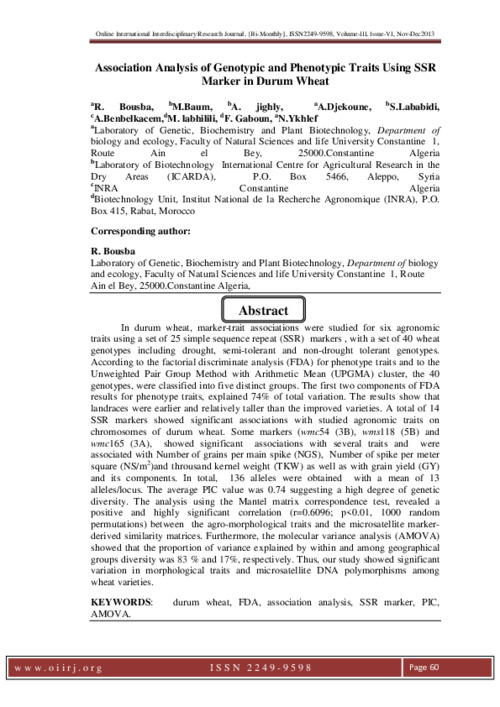Association Analysis of Genotypic and Phenotypic Traits Using SSR Marker in Durum Wheat
Abstract
In durum wheat, marker-trait associations were studied for six agronomic
traits using a set of 25 simple sequence repeat (SSR) markers , with a set of 40 wheat
genotypes including drought, semi-tolerant and non-drought tolerant genotypes.
According to the factorial discriminate analysis (FDA) for phenotype traits and to the
Unweighted Pair Group Method with Arithmetic Mean (UPGMA) cluster, the 40
genotypes, were classified into five distinct groups. The first two components of FDA
results for phenotype traits, explained 74% of total variation. The results show that
landraces were earlier and relatively taller than the improved varieties. A total of 14
SSR markers showed significant associations with studied agronomic traits on
chromosomes of durum wheat. Some markers (wmc54 (3B), wms118 (5B) and
wmc165 (3A), showed significant associations with several traits and were
associated with Number of grains per main spike (NGS), Number of spike per meter
square (NS/m2)and throusand kernel weight (TKW) as well as with grain yield (GY)
and its components. In total, 136 alleles were obtained with a mean of 13
alleles/locus. The average PIC value was 0.74 suggesting a high degree of genetic
diversity. The analysis using the Mantel matrix correspondence test, revealed a
positive and highly significant correlation (r=0.6096; p<0.01, 1000 random
permutations) between the agro-morphological traits and the microsatellite markerderived
similarity matrices. Furthermore, the molecular variance analysis (AMOVA)
showed that the proportion of variance explained by within and among geographical
groups diversity was 83 % and 17%, respectively. Thus, our study showed significant
variation in morphological traits and microsatellite DNA polymorphisms among
wheat varieties

